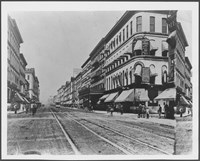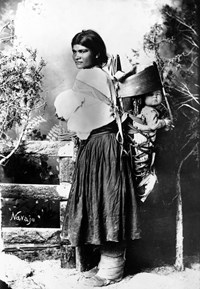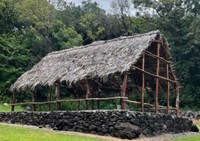- Lesson Plan (119)
- Field Trips (43)
- Distance Learning (26)
- Student Activities (13)
- Traveling Trunk (12)
- Other Education Materials (6)
- Primary Sources (6)
- Guest Speakers (4)
- Teacher Reference Materials (4)
- Media for Loan (1)
- Teacher Workshops & Other Programs (1)
- Dayton Aviation Heritage National Historical Park (17)
- Castillo de San Marcos National Monument (13)
- Fort Matanzas National Monument (9)
- Gateway Arch National Park (9)
- Carl Sandburg Home National Historic Site (8)
- Wright Brothers National Memorial (7)
- Charles Young Buffalo Soldiers National Monument (6)
- Fort Larned National Historic Site (6)
- Harriet Tubman Underground Railroad National Historical Park (6)
- Show More ...
- Social Studies (200)
- Literacy and Language Arts (99)
- Science (27)
- Math (16)
Showing 226 results for hispanic heritage ...
Why Visit His Home?
Understanding World Heritage
- Type: Lesson Plan
- Grade Levels: Upper Elementary: Third Grade through Fifth Grade
What is a world heritage site, why are they selected, and what can my community and I do to help preserve heritage sites in my community and globally?
American Heritage Merit Badge
- Type: Field Trips
- Grade Levels: Middle School: Sixth Grade through Eighth Grade

Explore the history of St. Louis and learn about the important role this river city played in the development of our nation. Afterwards, take a cruise on the Mississippi River, aboard the Gateway Arch Riverboats, and experience the river first-hand. Presentation will take place at the Museum at Gateway Arch National Park and the Gateway Arch Riverboats. The workshop is free. The cost for the Gateway Arch River Cruise TBD.
Heritage of the Southwest Traveling Trunk
- Type: Traveling Trunk
- Grade Levels: Upper Elementary: Third Grade through Fifth Grade
George Washington Carver - The Artist: Resource to His People
He Aha Lā He Kūkulu?
Herring Highway
Cayuse, Umatilla, and Walla Walla Homeland Heritage Corridor
- Type: Lesson Plan
- Grade Levels: Upper Elementary: Third Grade through Fifth Grade
Explore Cayuse culture by listening to primary sources from the Cayuse, Umatilla, and Walla Walla Homeland Heritage Corridor audio. The CD is currently available through the Tamastslikt Cultural Institute. Hear stories and history from modern day Cayuse people while considering the values that have guided Cayuse people through millennia. Students will need to practice critical listening skills and form their own analysis based on what they hear.
Commemoration, Memorialization, and Legacy: An Exploration of the Public and Private Memory of John F. Kennedy and His Presidency
- Type: Lesson Plan
- Grade Levels: High School: Ninth Grade through Twelfth Grade

This lesson will allow students to explore the theme of commemoration, memorialization, and legacy through reading of primary and secondary sources. They will engage in a consideration of how historical memory is shaped and how we commemorate people and places. The lesson will also allow students to make connections about their own thoughts and feelings regarding history and how it is commemorated.
Abraham Lincoln: Savior of the Union
Tort Liability: Franke v. City of St. Louis
- Type: Field Trips
- Grade Levels: Upper Elementary: Third Grade through Fifth Grade

Frederick Franke was injured in St. Louis when part of a building fell on his head as he was walking. Tragically, he died as a result of his injuries. His mother, Julia Franke, sued the owner of the building and the City of St. Louis for damages. This case was heard in 1888 in the St. Louis Courthouse (the Old Courthouse). Students will reenact the case and hear from all sides.
George Washington Carver - An Original Conservationist: The Man, the Scientist, The Artist
- Type: Lesson Plan
- Grade Levels: High School: Ninth Grade through Twelfth Grade

Today’s focus is to gather a basic understanding of who GWC was, where he came from, how he got his education, what purpose he saw for his life and the focus of his work. More depth can be added by having students complete presentations over Carver. By breaking the class into groups each group can do their own presentation over the whole topic or can be focused on one portion so that through the whole class all the information is gathered and provided to students.
Brigadier General Charles Young: The Responsible Leader!
- Type: Distance Learning
- Grade Levels: Upper Elementary: Third Grade through Fifth Grade

Charles Young was born enslaved and became the first African American to attain the rank of Colonel in the U.S. Army. Young called several places home during three distinct stages of his life: when he was a youth, a junior officer, and a seasoned veteran. Discover what changed in his life during these five eras of Charles Young’s life from where he called home and what he was responsible for.
Brigadier General Charles Young: The Responsible Leader!
- Type: Lesson Plan
- Grade Levels: Upper Elementary: Third Grade through Fifth Grade

Charles Young was born enslaved and became the first African American to attain the rank of Colonel in the U.S. Army. Young called several places home during three distinct stages of his life: when he was a youth, a junior officer, and a seasoned veteran. Discover what changed in his life during these five eras of Charles Young’s life from where he called home and what he was responsible for.
Charley's Trunk
Henry O. Flipper, Colored Cadet at West Point
- Type: Guest Speakers
- Grade Levels: Adult Education

Henry O. Flipper was born enslaved and became the first African American officer and graduate from the United States Military Academy at West Point in 1877. However, during his fifth year of service, on June 30, 1882, he was dishonorably discharged from the Army. Flipper fought to regain his honor for the rest of his life. He continued to serve as a public servant, working for the Department of the Interior as well as an engineer.
Benjamin O. Davis, Jr.: From Fourth Graduate to Four Star General
- Type: Distance Learning ... Guest Speakers
- Grade Levels: Adult Education

General Benjamin O. Davis, Jr. built a legacy well beyond being the fourth African American to graduate from West Point. He learned from the legacies that came before him to go further and higher in his military career. He commanded the Buffalo Soldiers, the Tuskegee Airmen, and served all over the world. Even after retirement, he continued to serve the public in various administrations, creating change on various levels to leave a legacy all his own.
"The Measure of a Man's Success in Life is Not the Money He's Made. It's the Kind of Family He Has Raised.": Separating the Myth from Reality in the Life and Times of Joseph Patrick Kennedy Sr.
- Type: Lesson Plan
- Grade Levels: High School: Ninth Grade through Twelfth Grade

This lesson plan allows high school students to identify who Joseph P. Kennedy Sr. was and his role in United States history. Students will examine Kennedy family photographs, letters from Joseph P. Kennedy Sr. to his family, and quotes from Joseph P. Kennedy Sr., to form their understanding of his influence. Students will evaluate the ways in which historians form complex understandings of controversial historical figures.
Carl Sandburg's Connemara (Grades 9-12)
- Type: Lesson Plan
- Grade Levels: High School: Ninth Grade through Twelfth Grade
A list of the Union soldiers buried at Andersonville
- Type: Primary Sources
- Grade Levels: Upper Elementary: Third Grade through Fifth Grade

Dorence, a prisoner held at Andersonville for eleven months, spent much of his time held at the prison as a paroled prisoner, working in the hospital office as a clerk. It was in this capacity that he made a secret copy of the death register. He and Clara Barton accompanied the Army expedition to Andersonville in the summer of 1865.








